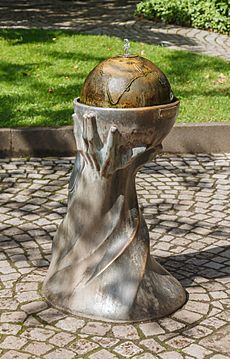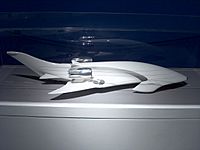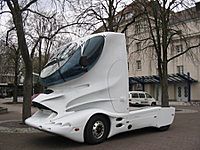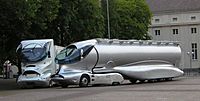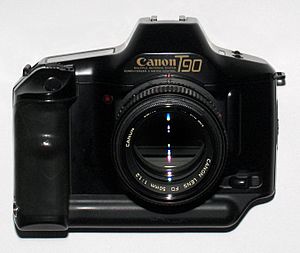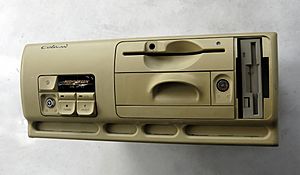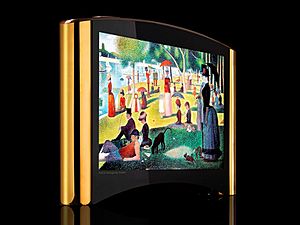Luigi Colani facts for kids
Quick facts for kids
Luigi Colani
|
|
|---|---|
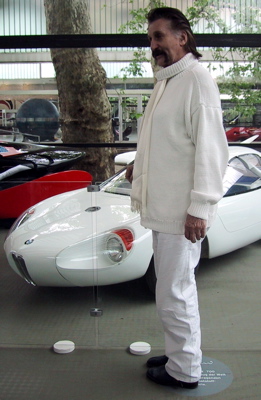
Luigi Colani in front of his BMW 700 in the exhibition "COLANI – Das Lebenswerk" (Karlsruhe) in 2004
|
|
| Born |
Lutz Colani
2 August 1928 Berlin
|
| Died | † 16 September 2019 (aged 91) Karlsruhe, Germany
|
| Occupation | Engineer |
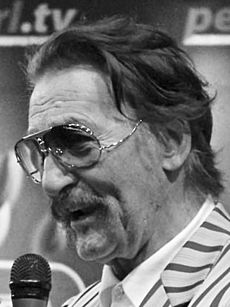
Luigi Colani (born Lutz Colani on August 2, 1928 – September 16, 2019) was a famous German industrial designer. He created many different things, from cars to furniture and even everyday items.
His long career started in the 1950s. He designed cars for big companies like Fiat, Alfa Romeo, and BMW. In 1957, he changed his first name from Lutz to Luigi. In the 1960s, he started designing furniture. By the 1970s, he designed many more things. These included ballpoint pens, television sets, uniforms, trucks, and even whole kitchens. One of his most striking designs is the Pegasus grand piano. It is still made and sold by the Schimmel piano company.
Colani became well-known for his unique designs. He won many design awards. Even though his ideas were often different, people loved his work.
Contents
What Was His Design Style Like?
Colani's designs are known for their smooth, rounded, and organic shapes. He called this style "biodynamic." He believed these shapes were better for people to use. This is also known as ergonomics.
His "kitchen satellite" from 1969 is a great example of his style. Many of his smaller designs were made and sold. However, some of his bigger, more futuristic ideas were never built. These included cars so flat you might need to bend your legs in a strange way!
Colani's Early Life and Career
Luigi Colani was born in Berlin, Germany. His father was a Swiss film set designer. His mother was from Poland.
How His Career Started in the 1950s
By 1953, Colani was living in California, USA. He worked at McDonnell Douglas, a big aerospace company. There, he led a group that worked with new materials.
In 1954, he started designing cars. He won the Golden Rose international prize in Geneva, Switzerland. This was for a special Fiat car body. He designed many Fiat cars in the years that followed. He was always trying new things. By 1958, he was also interested in designing sailing boats. His catamaran design won races in Hawaii.
In 1963, he created the world's first sports car made from plastic. It was based on the BMW 700. In 1960, he made the first "kit car" sold in large numbers. This was the Colani GT. About 1,700 of these cars were sold. In 1966, he showed his sports coupe design at a big car show in Frankfurt.
His Designs in the 1960s
By the 1960s, Colani's designs included household items and furniture. He started in 1963 with his famous elephant piggy bank. In 1965, his furniture designs became popular worldwide. He designed for companies like Asko and Fritz-Hansen. He also redesigned an Abarth Alfa Romeo car.
In 1968, he created a two-piece plastic cutlery set for Thai Airways International. The Museum of Design, Zürich even added it to its collection.
What He Did in the 1970s
By 1970, Colani was very successful. He opened a large design studio at Harkotten Castle in Germany. His studio was a huge success. They worked for many major companies around the world. He also kept designing new cars. This included his 1972 design for the Eifelland Formula One car.
During this time, Colani started working in Japan. He visited the Far East in 1973. Japanese companies saw his talent. Five companies invited him to open a Colani Design Center in Japan.
Around this time, he designed the "Drop" teapot for Rosenthal. This company is famous for porcelain. The teapot was so special that the Cooper-Hewitt Museum in New York bought it for their collection. In 1999, Rosenthal even made a special edition of this famous teapot.
Not all of his designs were big hits. For example, he designed an Olympic row boat that was not successful. In the early 1970s, he also created his first streamlined truck design. He said, "nobody noticed my design." He designed more streamlined trucks later, which got more attention.
Colani's first job was designing aircraft. He returned to this in 1976. He designed the RFB Fanliner, the first plastic sports airplane with a Wankel engine. Later, in 1985, he showed the Colani Pontresina propeller plane. This plane had new "centripetal supersonic propellers." It was a design study and could not actually fly.
By 1978, his amazing trucks, aircraft, cars, and ship designs were shown at exhibitions worldwide. He was very interested in saving fuel. In 1981, he set a world record for fuel economy. His four-seater Colani 2CV car used only 1.7 liters of gasoline to travel 100 km. It used a standard Citroën 2CV engine and chassis.
What He Created in the 1980s
In 1982, Colani moved to Japan. A year later, he became a professor in Tokyo.
He designed "5 Systems" camera prototypes for Canon. In 1984, he was named the top industrial designer in Japan. This was at the Otaru exhibition. In 1986, he won the Golden Camera Award for the Canon T90.
In 1985, his Robot Theater was the most popular exhibit at Expo '85.
In 1986, one of his motorcycles set a world record in Italy. That year, he started Colani Design Bern in Switzerland.
He continued to show his designs at international exhibitions. This included a 1987 show at Centre Georges Pompidou in Paris. He designed cars for Mazda in Japan. He also designed a pen for Pelikan A.G. in Germany. The Colani Cormoran aircraft design was shown as a model at the Paris Air Show.
In 1988, he opened offices in Toulouse and Bremen. He also became a professor at the University of the Arts Bremen. He planned to set new speed records on land, water, and in the air. He also aimed for economy world records in Utah. In 1991, he set records in a special Ferrari at Bonneville Speedway.
In 1989, he started Colani Trading AG in Zurich, Switzerland.
Also in 1989, Colani organized "AUTOMORROW '89." Twelve futuristic vehicles traveled across the U.S. in two trucks. There were talks and demonstrations at Ford in Detroit. They also did test drives on the Bonneville salt flats.
His Work in the 1990s
The 1990s brought more exhibitions and designs. He had an exhibition at the Centre International de l'Automobile car museum in Paris. In 1993, he held shopping center shows across Switzerland.
He designed new uniforms for aircrew at Swissair. These were the last designs used before the airline became Swiss in 2002. In 1991, he designed glasses frames and jewelry. Other designs included binoculars (1993) and office furniture for Grahl, USA (1996). He also designed a new piano for Wilhelm Schimmel (1997). He created a water bottle design for Carolinen-Brunnen, Germany. In 1998, he designed a new microscope and a photo camera. In 1999, he designed new showers for Dusar and furniture for Kusch & Co., Germany.
In 1997, he designed the "Pegasus" grand piano with the German company Schimmel Pianos. This design changed the traditional look of pianos. Schimmel builds only two of these pianos each year, and only when ordered. Famous people like Prince, Lenny Kravitz, and Eddy Murphy have owned a Pegasus piano.
The 1990s and 2000s also saw him design computer items. Projects included a computer mouse for Sicos (1992). The Colani Vobis Highscreen computer was named Computer of the Year in 1994. In 1998, he worked on a bank terminal design.
By 1995, he started designing whole buildings. That year, he completed designs for big construction companies. China's ambassador invited Colani to Shanghai for future projects. There, he became an honorary professor at Tongji University. The next year, he showed his architecture project for Shanghai, called Bio-City.
His Projects in the 2000s
His architectural designs continued. He created the "Human-City" model for MW Energie AG in Mannheim, Germany (2000). Then, he designed an experimental house for Hanse-Haus, a German company that builds prefabricated homes.
He designed new glasses frames shown in Milan, Paris, and Las Vegas. In 2001, he designed a new microscope and photo camera for Seagull at his Shanghai office. He held over thirty exhibitions in shopping malls across Germany. In 2002, a world-leading design museum, Pinakothek der Moderne, opened in Munich, Germany. It featured several of Colani's designs.
For packaging, he designed a new bottle for Valser, a Swiss mineral water company. He also created porcelain giftware, like Cappuccino and Espresso mugs.
He worked on a "Life on Board" project for Volvo cars. He also created a futuristic car design called the Speedster shark. He continued his large Supertruck designs with extreme streamlining. This time it was for Spitzer-Silo. The result was shown at a big exhibition in Hanover, Germany (2004).
A notable uniform design was for the Hamburg Police department in 2003. This design was later used by police forces across Germany.
From 2004 to 2007, an exhibition of Colani's work took place in Karlsruhe. It was called COLANI – Das Lebenswerk.
In 2007, the Design Museum in London showed his work in an exhibit called Translating Nature.
In aircraft design, he created the tt-62-plane for hp-aircraft.de. He also completed a design study for a 1,000-seat passenger airplane (2005).
He made 140 sculptures of athletes for the Olympic Games in Beijing. He also took part in the "Germany in Japan 2005-6" event. This was the "Colani Back in Japan" exhibition at the Museum for Art and Design in Kyoto. He also studied how to design a robot shaped like a baby.
In 2013, the first model (AC22) of the AGOS Luxury Computer Series, Opus Magnum, was shown in Marburg, Germany.
Colani's Family Life
Luigi Colani was married to Ya Zhen Zhao since the 1990s. He lived in Shanghai, China. His son, Solon Luigi Colani, lives in Berlin. He also works as a designer and creates special effects for movies.
Colani was a guest speaker at the 2004 World Economic Forum in Davos, Switzerland.
Luigi Colani passed away in Karlsruhe in 2019.
His brother, Victor Colani (born 1933), was also a designer.
See also
In Spanish: Luigi Colani para niños


